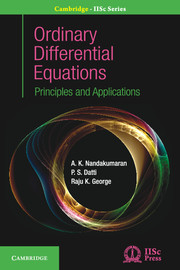Book contents
- Frontmatter
- Dedication
- Contents
- Figures
- Preface
- Acknowledgement
- 1 Introduction and Examples: Physical Models
- 2 Preliminaries
- 3 First and Second Order Linear Equations
- 4 General Theory of Initial Value Problems
- 5 Linear Systems and Qualitative Analysis
- 6 Series Solutions: Frobenius Theory
- 7 Regular Sturm–Liouville Theory
- 8 Qualitative Theory
- 9 Two Point Boundary Value Problems
- 10 First Order Partial Differential Equations: Method of Characteristics
- Appendix A Poincarè–Bendixon and Leinard's Theorems
- Bibliography
- Index
1 - Introduction and Examples: Physical Models
Published online by Cambridge University Press: 14 December 2017
- Frontmatter
- Dedication
- Contents
- Figures
- Preface
- Acknowledgement
- 1 Introduction and Examples: Physical Models
- 2 Preliminaries
- 3 First and Second Order Linear Equations
- 4 General Theory of Initial Value Problems
- 5 Linear Systems and Qualitative Analysis
- 6 Series Solutions: Frobenius Theory
- 7 Regular Sturm–Liouville Theory
- 8 Qualitative Theory
- 9 Two Point Boundary Value Problems
- 10 First Order Partial Differential Equations: Method of Characteristics
- Appendix A Poincarè–Bendixon and Leinard's Theorems
- Bibliography
- Index
Summary
A Brief General Introduction
The beginning of the study of ordinary differential equations (ODE) could perhaps be attributed to Newton and Leibnitz, the inventors of differential and integral calculus. The theory began in the late 17th century with the early works of Newton, Leibnitz and Bernoulli. As was customary then, they were looking at the fundamental problems in geometry and celestial mechanics. There were also important contributions to the development of ODE, in the initial stages, by great mathematicians – Euler, Lagrange, Laplace, Fourier, Gauss, Abel, Hamilton and others. As the modern concept of function and analysis were not developed at that time, the aim was to obtain solutions of differential equations (and in turn, solutions to physical problems) in terms of elementary functions. The earlier methods in this direction are the concepts of integrating factors and method of separation of variables.
In the process of developing more systematic procedures, Euler, Lagrange, Laplace and others soon realized that it is hopeless to discover methods to solve differential equations. Even now, there are only a handful of sets of differential equations, that too in a simpler form, whose solutions may be written down in explicit form. It is in this scenario that the qualitative analysis – existence, uniqueness, stability properties, asymptotic behaviour and so on – of differential equations became very important. This qualitative analysis depends on the development of other branches of mathematics, especially analysis. Thus, a second phase in the study of differential equations started from the beginning of the 19th century based on a more rigorous approach to calculus via the mathematical analysis. We remark that the first existence theorem for first order differential equations is due to Cauchy in 1820. A class of differential equations known as linear differential equations, is much easier to handle. We will analyse linear equations and linear systems in more detail and see the extensive use of linear algebra; in particular, we will see how the nature of eigenvalues of a given matrix influences the stability of solutions.
- Type
- Chapter
- Information
- Ordinary Differential EquationsPrinciples and Applications, pp. 1 - 21Publisher: Cambridge University PressPrint publication year: 2017



